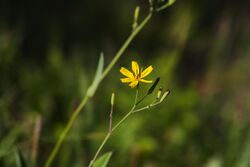Biology:Ixeridium dentatum
| Ixeridium dentatum | |
|---|---|

| |
| Scientific classification | |
| Kingdom: | Plantae |
| Clade: | Tracheophytes |
| Clade: | Angiosperms |
| Clade: | Eudicots |
| Clade: | Asterids |
| Order: | Asterales |
| Family: | Asteraceae |
| Genus: | Ixeridium |
| Species: | I. dentatum
|
| Binomial name | |
| Ixeridium dentatum (Thunb. ex Thunb.) Tzvelev
| |
| Synonyms | |
|
Chondrilla dentata (Thunb.) Poir. | |
Ixeridium dentatum, the toothed ixeridium,[1] is a species of flowering plant in the family Asteraceae, native to East Asia (China , Japan , Korea, and Russia n Far east).[2]
It is a perennial plant whose leaves and stems and produce a white juice with a bitter taste.[3]
Description
It's commonly found on the sides of roads, and in the wilderness, throughout Japan, Korea, and parts of China. It grows to about 20-40 centimeters tall. It has yellow, usually five petaled flowers that bloom in the spring. Its rhizome is short, its stem is thin and upright, and the stem branches near the top. Its leaves are broad and lanceolate. It prefers partial shade. In Japan, it's known as “nigana” which literally translates to English as “bitter greens.” However, other plants of this genus are also known as “nigana” in Japanese, so it's not a specific term.[4]
Uses
Used as a folk remedy in Japan where it's said to relieve indigestion and reduce inflammation. The whole plant is used as a remedy including roots. The plant is harvested during its flowering period, and then washed and dried before consuming.[5]
References
- ↑ English Names for Korean Native Plants. Pocheon: Korea National Arboretum. 2015. pp. 502. ISBN 978-89-97450-98-5. http://www.forest.go.kr/kna/special/download/English_Names_for_Korean_Native_Plants.pdf. Retrieved 7 January 2017.
- ↑ "Taxon: Ixeridium dentatum (Thunb.) Tzvelev". National Plant Germplasm System. 11 August 1999. https://npgsweb.ars-grin.gov/gringlobal/taxonomydetail.aspx?411136.
- ↑ "Ixeris dentata". https://terms.naver.com/entry.nhn?docId=1922624&cid=46686&categoryId=46694.
- ↑ https://www.lab2.toho-u.ac.jp/phar/yakusou/mihon/nigana.html
- ↑ https://www.lab2.toho-u.ac.jp/phar/yakusou/mihon/nigana.html
Wikidata ☰ Q5710382 entry
 |

